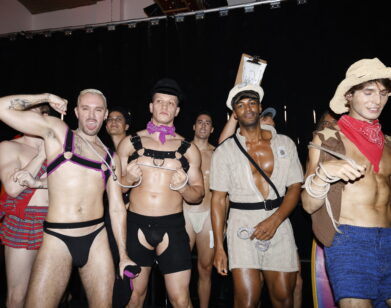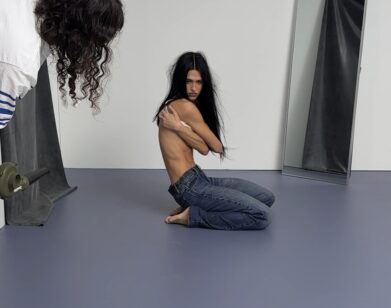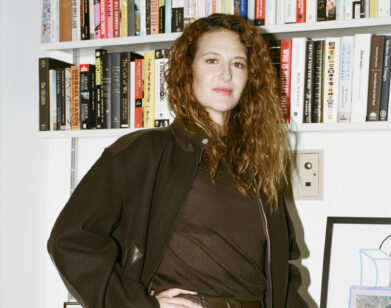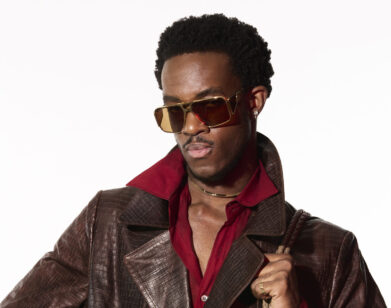JOURNALISM
Robin Givhan on the State of Fashion Criticism in 2023

It may be graduation season, but at Interview, class is still in session. Following a trip to Pioneer Works to witness Pratt’s top fashion design students showcase their thesis collections, our senior editor Taylore Scarabelli called up the institute’s 2023 Fashion Visionary Award winner, journalist Robin Givhan, for a lesson on the state of fashion criticism in 2023.
———
FRIDAY 2:30PM MAY 12, 2023 NEW YORK
TAYLORE SCARABELLI: Hi, Robin.
ROBIN GIVHAN: Hi there. It’s nice to see you.
SCARABELLI: Thank you for doing this on a lovely Friday afternoon. I wanted to start by congratulating you on winning the Pratt Fashion Visionary Award.
GIVHAN: Thank you. It was an honor.
SCARABELLI: I think it’s interesting that they chose to give the award to a fashion critic this year, particularly because the state of fashion criticism appears to be in flux thanks to social media and new platforms like Substack. I’d love to hear your thoughts on the role of the fashion critic today.
GIVHAN: The role of the critic, whether it’s a critic who’s writing about fashion or visual arts or music, is the same. It’s to try and help the reader forge connections, to look at things in a different way. It’s to help them to navigate a fire hose of information and ideas, to provide a framework for thinking about the subject matter. I think sometimes people confuse the idea of criticism with having an opinion. I think it’s great that lots of people are drawn to fashion and have an opinion, and can put that opinion out there for public consumption. But I don’t think that that necessarily means that they’re a critic or that what they’re doing is criticism.
SCARABELLI: Exactly. I also feel like because of that, a lot of actual critics are being drowned out—especially considering the fact that people are being rewarded according to the amount of followers they have.
GIVHAN: I think that journalists are having a bit of difficulty being heard and believed sometimes and I think that criticism is part of that universe. I don’t peruse fashion critics in the fashion industry, because I think that really good critics adhere to the tenets of journalism. But I think that the way that media works now, particularly social media, sometimes thoughtfulness and value are measured in terms of followers, as opposed to content.
SCARABELLI: I’m wondering how that’s impacting young designers. Back in 2015, when there were a lot of young brands popping up in New York, I wrote about how new brands were getting a lot of press and attention that was disproportionate to their actual progress or success. I think it created this false narrative for a lot of people about access and the ease in which they can find success in the fashion industry. I was thinking about this again after seeing that Pratt Show—it was so lovely to see everybody do their thing and there was lots of interesting work—but I couldn’t help but think about how even within fashion school, people are being driven to start their own brands right off the bat. How does that intersect also with criticism and journalism? Is that just the way fashion is inherently, everyone wants to be a star? Or are we creating this false narrative about the industry?
GIVHAN: Doesn’t everyone want to be a star?
SCARABELLI: Yes. [Laughs]
GIVHAN: There’s a long history of there being an imbalance between the critical praise or industry praise that a designer might be receiving, and the actual health and profitability of their company. I think about brands going all the way back to Isaac Mizrahi. He was quite celebrated and incredibly talented, but it was still a company that was really struggling to be profitable. I think that’s gotten exaggerated now in the way that everything seems to be exaggerated and sped up today. I think every industry benefits from thoughtful outside criticism. I do think that something is lost when young designers don’t get that, when all they’re hearing is a constant drumbeat of, “You’re doing great, you’re amazing, get bigger, design more collections.”
SCARABELLI: It’s no secret that the majority of fashion reporting is pay for play. I’m wondering if this is, in part, a result of that? Even the younger players, who aren’t necessarily paying for content, are still being treated in this non-critical way as if that’s how quote unquote fashion journalists have been trained to report on them.
GIVHAN: A huge part of it is that writers operating within the fashion space are part of the fashion ecosystem. They’re rooting for designers because whenever there’s the possibility of a bright, new, shiny object, that’s exciting and it’s something to write about and it’s something to champion. Fashion is always searching for the next thing. I think it’s really easy to slip into this desire to light a fire under young designers who look promising. It’s much harder and I think it’s the antithesis to what fashion is about to say, “Slow down, that perhaps they’re not ready to not leap ahead, to not do the red carpet gown, to not do the collaboration.” That, I think, goes against the very core of what fashion is about.
SCARABELLI: Whereas criticizing a young designer could come from a place of love and a desire to actually nurture that person’s career. I think an important part of fashion criticism is that it helps people grow and develop and contextualize their work. Today, it’s harder to do that also because of the armies of people online who would immediately label you a hater, particularly when it comes to designers who have traditionally been ostracized by the industry.
GIVHAN: I think that sometimes there are designers who come to step into the spotlight and people are so hungry to see themselves reflected in a designer who is being championed or is having a moment that it’s very hard to pull back. But I know that as a writer, the editors who have made me better have always been the ones who have offered thoughtful critiques and have told me when something is not great.
SCARABELLI: Totally. I’m wondering where you think fashion criticism should or can live? Because for me, the only time I’ve ever been able to be open and honest is writing for very small independent publications who don’t have advertisers. Being an editor at a fashion magazine, I can no longer say the things I was once able to. But I notice that even at publications like the Times, people seem to be self-censoring.
GIVHAN: I’ve always been a believer that more newspapers, more general interest publications, should cover the fashion industry. I think it’s important that the Times and the Washington Post cover the fashion industry. I would love to see The Los Angeles Times get back to covering more of the fashion industry. I would love to see it in the pages of The Wall Street Journal. I would love to see it in Time Magazine. I like to see it in The New Yorker. I think it’s important that the publications that do not rest on having advertising from the fashion industry but have a broad swath of advertising, or are not dependent on advertisers at all [cover fashion]. I would love to see ProPublica covering the fashion industry. This is a global industry that affects every single one of us. It’s so enormous, it’s so influential. It is a form of communication that people rely on in ways that are both superficial and profound. I think it is a reflection of the secondary place that fashion occupies in popular culture. That it hasn’t been afforded the kind of close coverage that it deserves.
SCARABELLI: However, it seems like more and more people are interested in fashion right now, in terms of fashion as entertainment, fashion as sports or whatever. But perhaps there’s less of the fashion criticism that you became so well known for, which is talking about fashion in a broader context, as it relates to politics or culture more generally. Are people just so consumed with the shiny parts of the fashion world that they’re not really thinking about fashion in our day-to-day lives?
GIVHAN: I think people don’t necessarily know that they’re interested or don’t recognize that is essentially what they’re talking about. I was thinking about some of the incredible pushback against drag story hour at independent bookstores. There is a fashion element to that story that I think no one has really teased apart—the role that fashion plays in our discomfort with the way that gender is defined and displayed, and all of those thorny, complicated, important issues. To me, that’s a fashion story that has stirred up so much controversy and pain and misunderstanding, and misinformation that should live in general interest publications, should live in newspapers—perhaps in the politics section.
SCARABELLI: There are so many great essays that are tackling these issues, but I feel like they’ve all been driven underground. People are writing that way for small publications, but it’s only seen by a tiny subset of nerds who are interested in looking at culture that way. But I do think the moment is ripe to bring that back into the mainstream, so I hope we can. I wonder what you think about the Substack economy and the return of blogging, do you think that’s beneficial in any way? Or do you think that’s eroding journalism and journalistic standards?
GIVHAN: I would never say that a space that allows people to have interesting and thoughtful and personal conversations shouldn’t be celebrated. But I do think that our conversations are so siloed, and that so often we end up just preaching to our own little choir. There’s something to be said for having conversations like that on a large, mass platform because that’s the way that you engage the largest number of people. But I think it’s also the way that those who are not seeking out those stories have a better chance of stumbling across them. When I started covering fashion for The Post, I was happy that they didn’t have a “fashion section,” because it meant that fashion stories were displayed right alongside a political profile or a film review or a lifestyle story. It forced me to write in a way that was as welcoming as possible. Because I knew that the eyes that were going to fall on that story were not necessarily those who were fashion insiders, or people who just had an existing understanding of who this designer was or what the interplay was. But it also meant that people could serendipitously come across a fashion story and be drawn into it, and discover that it was a topic that was actually interesting to them and learn something. I think if more of those conversations can happen in a bigger space, then you can engage even the unwilling.
SCARABELLI: Yeah. I’m curious, because obviously you and I both don’t feel that fashion is superficial, but I can imagine that sometimes, if that’s your beat for so long, you might get tired of it or feel overworked or overthought. Why did you choose to step away from fashion into broader cultural criticism?
GIVHAN: I stepped away from it during the height of the pandemic during a lot of the social justice protests. Part of that was just because, like so many industries, fashion really slowed down so there wasn’t this onslaught of news that was coming out of it. It gave me a chance to focus on other topics. Then afterwards, I just found that I really wanted to spend more time writing in this broader way. I still drift back to fashion, but it’s not my beat anymore. We hired the wonderful Rachel Tashjian as fashion writer and now I get to focus on those places of overlap where fashion meets politics, meets race, meets gender, meets culture, and explore those spaces, which I love and I find really interesting. It’s a way into a lot of different stories. But I certainly would not have covered fashion or focused on fashion for as long as I did if I hadn’t found it completely fascinating. Just when I would start to think that I can’t do another round of fashion shows, there’d be some new designer or some business machination or some trend that would appear that would be absolutely captivating.
SCARABELLI: Do you have any advice for young people trying to step into fashion criticism right now?
GIVHAN: I often have young writers ask about finding their voice and being able to write with authority. I always say to them that it just takes time. That you just have to write. I’m sure there are those amazing alien beings who emerged from the womb being able to just write brilliantly in a distinctive voice. But most writers that I know developed their voice over time. Confidence and authority comes from knowledge and experience. The more that you learn about the industry, the more context you have, the more you can write with confidence and the more you can write with authority. I always encourage people to read widely, and not just on the topic of fashion, but on a multitude of topics. Because you learn from other writers, you never know what other topics are going to spur a thought that helps you better understand fashion. Then I would also say that I think you need to figure out who you’re writing for. If you are writing for an audience of fashion fans, I think that’s one thing. But if you’re writing for a readership that you believe is somewhat skeptical about fashion, then I think you respond differently.
SCARABELLI: Do you have any advice for people who are writing for fashion magazines? How do you craft a voice within a system that’s behest to advertisers?
GIVHAN: Honestly, I don’t know that you can. I think that if you have been hired to write for a publication that has a philosophy of celebrating the fashion industry, then that’s what you signed up for. To me, it seems like it would be a bit of an exercise and frustration to say that you signed up for one thing and with the intent of going in and creating upheaval. I think that the places where you can perhaps make an impact is in the voices that you do celebrate and the people that you invite to the table as examples of what makes fashion wonderful. You may not become the internal critic of the fashion industry. But I think that you can certainly invite more people to the party.
SCARABELLI: Before the Pratt Runway Show, you finished your acceptance speech by asking the graduating class to cherish their critics.
GIVHAN: That was slightly self-serving, right?
SCARABELLI: [Laughs] I think it’s to everyone’s benefit, really.
GIVHAN: Yeah. One of the reasons that I said that was because I think that too often, young designers don’t have the benefit of someone who doesn’t have a vested interest in their business to give them honest feedback. I think that honest feedback should be cherished—that is a presumption that it is being given with thoughtfulness and without being personal about it. I think that also sets you up to be a more professional, thoughtful, and confident designer. If you can take constructive criticism, you can build a toughness and an understanding that the industry is not about your own personal indulgence. But that it is a business and that you are in service to your customers, not the other way around. I think that just makes for a better, more substantial and hopefully more lasting business.
SCARABELLI: Well, thank you. I wanted this to be a helpful conversation for aspiring critics, because I get so many emails asking, “What do I do? How do I do it?” And I think it was.
GIVHAN: People have asked me so many times, “How did you get your job?” Sadly, I have to say, “The route that I took really doesn’t exist anymore.” I started covering fashion at a smaller regional newspaper. While it’s certainly still possible to be at a smaller newspaper and to write about fashion. I had the benefit of working at a paper that every season sent not only a writer but a photographer to cover collections in New York and in Europe. When I started, I wasn’t even the primary fashion writer. I was the secondary writer who covered menswear. That kind of attention to the industry, that kind of budget, it just doesn’t exist anymore. But even if you’re at a fashion magazine where you don’t feel like you can fully be the writer that you want to be, you can still make choices that have an impact. There are a host of digital publications to help you hone your craft. “Just write,” that’s what I tell people.






